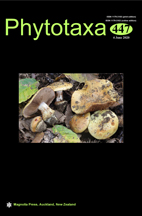Abstract
Two types of Wilmottia (Cyanobacteria) were collected from the tree-bark of a tree on Mt. Gwanggyo in Suwon City, Gyeonggi-do and a rock wall of Haje Port, Geum River in Jeollabuk-do, Republic of Korea. Morphological observations using light microscopy (LM) and transmission electron microscopy (TEM) revealed that one species was Wilmottia murrayi (Coleofasciculaceae, Oscillatoriales) and the other had similar morphology to W. murrayi, with considerable genetic variations, and thus, it was described as a new species named Wilmottia koreana. Phylogenetic analyses of the 16S rRNA revealed that the family Coleofasciculaceae was clearly separated into taxonomic groups of each genus, and in them, Wilmottia forms a monophyletic lineage. W. koreana diverged the earliest, forming a unique clade separate from the others. Statistical analyses showed that the inter-species genetic distances of Wilmottia were significantly different from the intra-species distances (t-test, P < 0.001). Additionally, the secondary structures of D1–D1’, Box-B, and the V3 helices were different among the Wilmottia species. These results demonstrated that the proposed new Wilmottia species was unique in molecular traits. Therefore, we propose this to be a new species belonging to the genus Wilmottia with the name Wilmottia koreana sp. nov.

